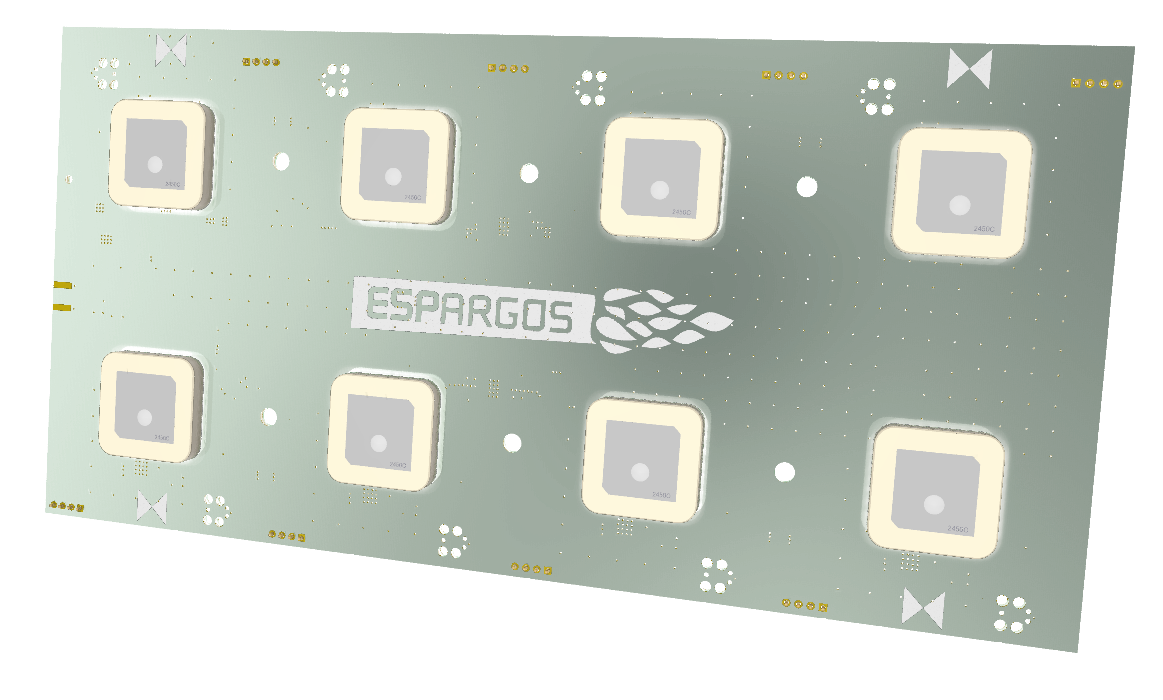
ESPARGOS: ESP32-based WiFi sensing array
Develop and deploy WiFi sensing applications effortlessly: ESPARGOS is a phase-coherent ESP32 antenna array.
Channel State Information
ESPARGOS provides Channel State Information (CSI) estimated from the L-LTF and HT-LTF pilot symbols in real time. Viewed in frequency domain, CSI contains information about the phase shift and attenuation experienced by the OFDM subcarriers. After a fourier transform, CSI can be interpreted as a channel impulse response. ESPARGOS supports channel bonding, achieving a bandwidth of up to 40 MHz.
Power over Ethernet
Avoid the hassle of running separate data, power and signalling cables: ESPARGOS is controlled over Ethernet, provides a simple web interface for configuration and can be powered from a power over ethernet (PoE) switch / injector. This makes ESPARGOS easy to use and deployments are quick to set up.
Python Library
With pyespargos, there is an easy-to-use library to control one or multiple ESPARGOS devices.
Configure ESPARGOS with the built-in web interface, and then easily stream channel state information to your application in real time.
The python library comes with a collection of demo applications to get you started.
Demo Applications
Use the MUSIC algorithm for angle of arrival estimation: Visualize spatial spectrum.
View Demo on GitHubCombine multiple 2 × 4 ESPARGOS antenna arrays into one large phase-synchronous array.
View Demo on GitHubInstantaneous Frequency-Domain CSI
Visualize the frequency-domain channel state information captured by all antennas.
View Demo on GitHubVisualize the time-domain channel state information captured by all antennas.
View Demo on GitHubVisualize the received phase at each of the 2 × 4 antennas of the antenna array.
View Demo on GitHubMonitor the average received phase at all antennas as it changes over time.
View Demo on GitHubMonitor the precise time of arrival of WiFi packets at each antenna array.
View Demo on GitHubShow received WiFi signal power and delay as an overlay on top of a camera image.
View Demo on GitHubReal-Time Indoor Localization Demo
With ESPARGOS, existing WiFi devices like smartphones, robots and other machines can be localized in indoor environments without requiring any changes to those devices. In line-of-sight environments, ESPARGOS can simply locate devices by triangulation. Channel Charting allows the system to locate devices even if there is no line-of-sight path between ESPARGOS and the end device. This application was publicly demonstrated at the Berlin 6G Conference 2024.
How to obtain ESPARGOS?
At the Institute of Telecommunications at the University of Stuttgart, we have manufactured a small batch of ESPARGOS devices and are using them internally for testing.
The hardware design and firmware files of ESPARGOS are currently not open source, but the pyespargos library including the demo applications are Free Software.
I am now planning to commercialize ESPARGOS and am preparing a manufacturing run for ESPARGOS. This involves some PCB redesigns to make the design more mass-manufacturable, to get the cost further down, and to get it certified. This will obviously take some time. So sign up for email updates to stay up to date!
Sign up for Updates

